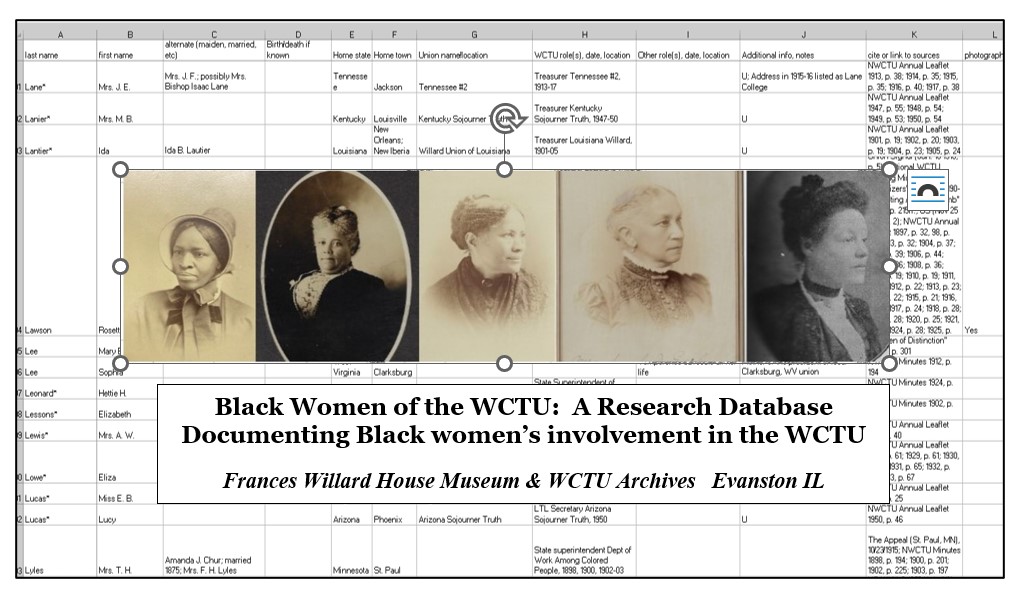
The following post was written and contributed by Janet Olson, Archivist at Frances Willard House Museum & WCTU Archives in Evanston, Illinois.
About Us
The non-profit Center for Women’s History and Leadership in Evanston, IL, manages the Frances Willard House Museum and Woman’s Christian Temperance Union (WCTU) Archives. The House Museum preserves and interprets the historic Willard home and its contents, and promotes discussion of Willard’s life and work on behalf of women, temperance, and human rights. The WCTU Archives’ collections, documenting the history of what was at one time the largest women’s organization in the U.S., benefit a global community of researchers in fields ranging from addiction studies to women’s social networks. All staff members—two in the Archives and two in the Museum–are part time.
How a Bug Became a Feature
This is the story of how we turned a literal bug into a feature. COVID has made us explore new ways to serve our Museum patrons and Archives researchers, and has energized us to think bigger, despite our small size.
The COVID lockdown cancelled tours and programs in the Museum and researcher visits in the Archives. Since the Archives is a standalone facility, Archives staff could open for restricted on-site research within a few months. Still, we knew that researchers would be slow to resume their visits. This gave us time to think: about research trends in history, women’s studies, and digital humanities; about new ways to present our resources; and about how to continue our exploration of race, class, and ethnicity in the history of the WCTU.
And so in early 2021, we initiated a long-term project: creating a research database to document the significant but underexplored role of Black women in the WCTU. The Black Women of the WCTU project builds on interest generated by our 2019 digital exhibit, Truth-Telling (about the conflict between Frances Willard and Ida B. Wells; https://scalar.usc.edu/works/willard-and-wells/index), a joint effort of the Museum and Archives which addressed racism in the WCTU. Our research for Truth-Telling showed that Black women had long participated in the WCTU, but that their activism had been little studied by historians.
The new database, consisting of names of individuals and locations of Black unions (WCTU branches) across the US, will provide information for researchers studying Black women’s activism and social networks. It is a research resource, rather than a site of storytelling and analysis—and for me, as a statistics-averse, narrative-driven archivist, one unexpected result of this project has been a new understanding of archives as data. I’m getting used to it.
The Archives’ extensive records of WCTU unions at the national and state level provide the basic resources for the project. Most useful are the printed Annual Reports, which list Union officers at national, state, and local level, and report on local work. Non-WCTU sources include biographical databases, digitized Black newspapers, and census records. We spent much time developing best practices for gathering names and locations and documenting each citation. The database, in basic spreadsheet form, now holds over 1000 names of Black WCTU women and the locations of over 150 Black WCTUs—a tiny sampling of what will eventually be included. And we have had enthusiastic response from researchers, advice from allies, and research help from (masked) volunteers, interns, and an entire class of Public History grad students.
However, the project itself is not the focus of this essay. You can read more about the process, the progress, and the challenges at https://tinyurl.com/2psb9dav. Why is this a COVID story rather than a report on an exciting new project? I see the Black Women of the WCTU as one way we disrupted the pandemic’s disruption of our routines and plans. The need to do more with less, which as a small organization we already understood, motivated us to build on our strengths, to innovate from within by expanding on pre-existing work. By featuring an important, underutilized set of resources, we have increased our visibility, and advanced our mission, in spite of the bug.